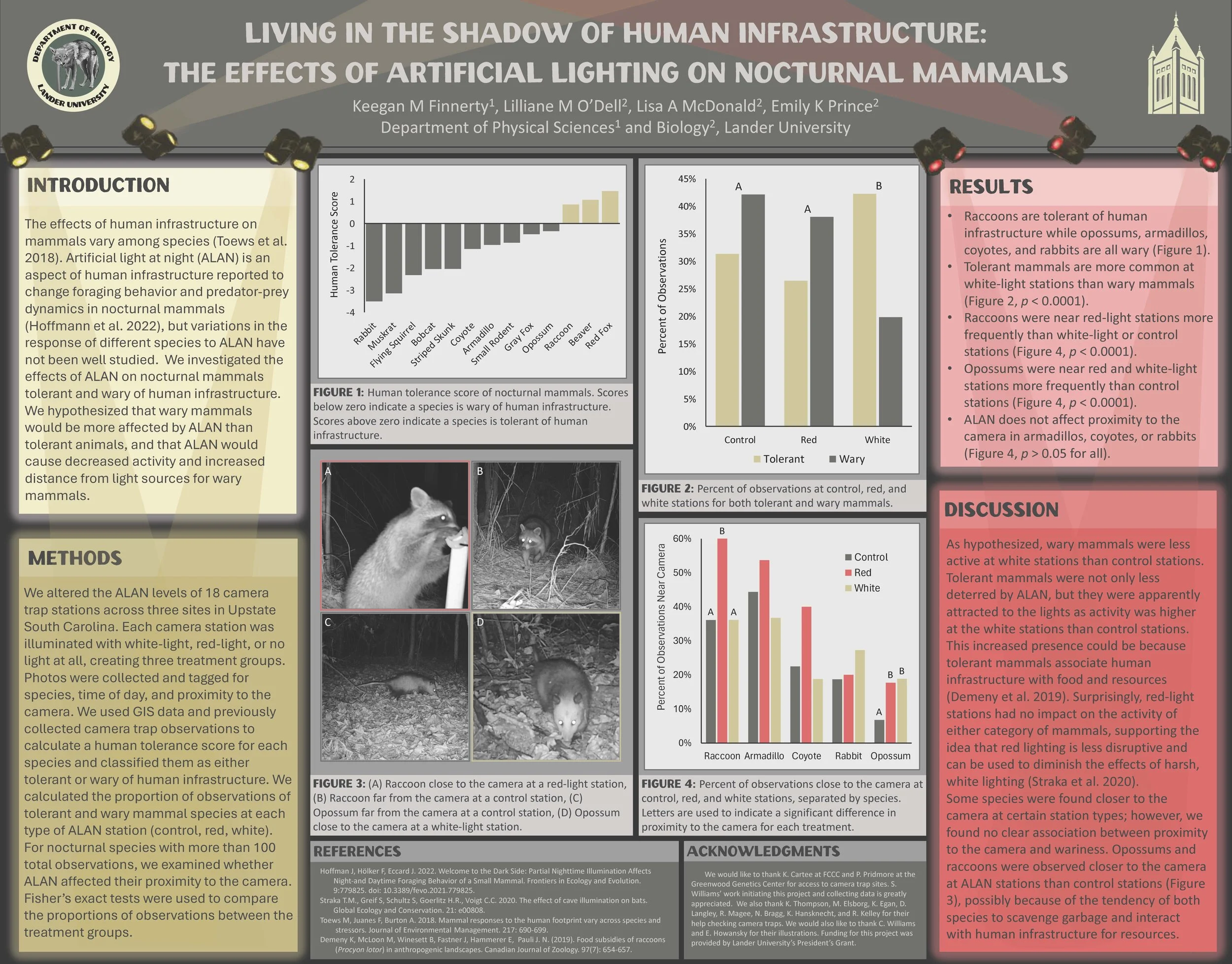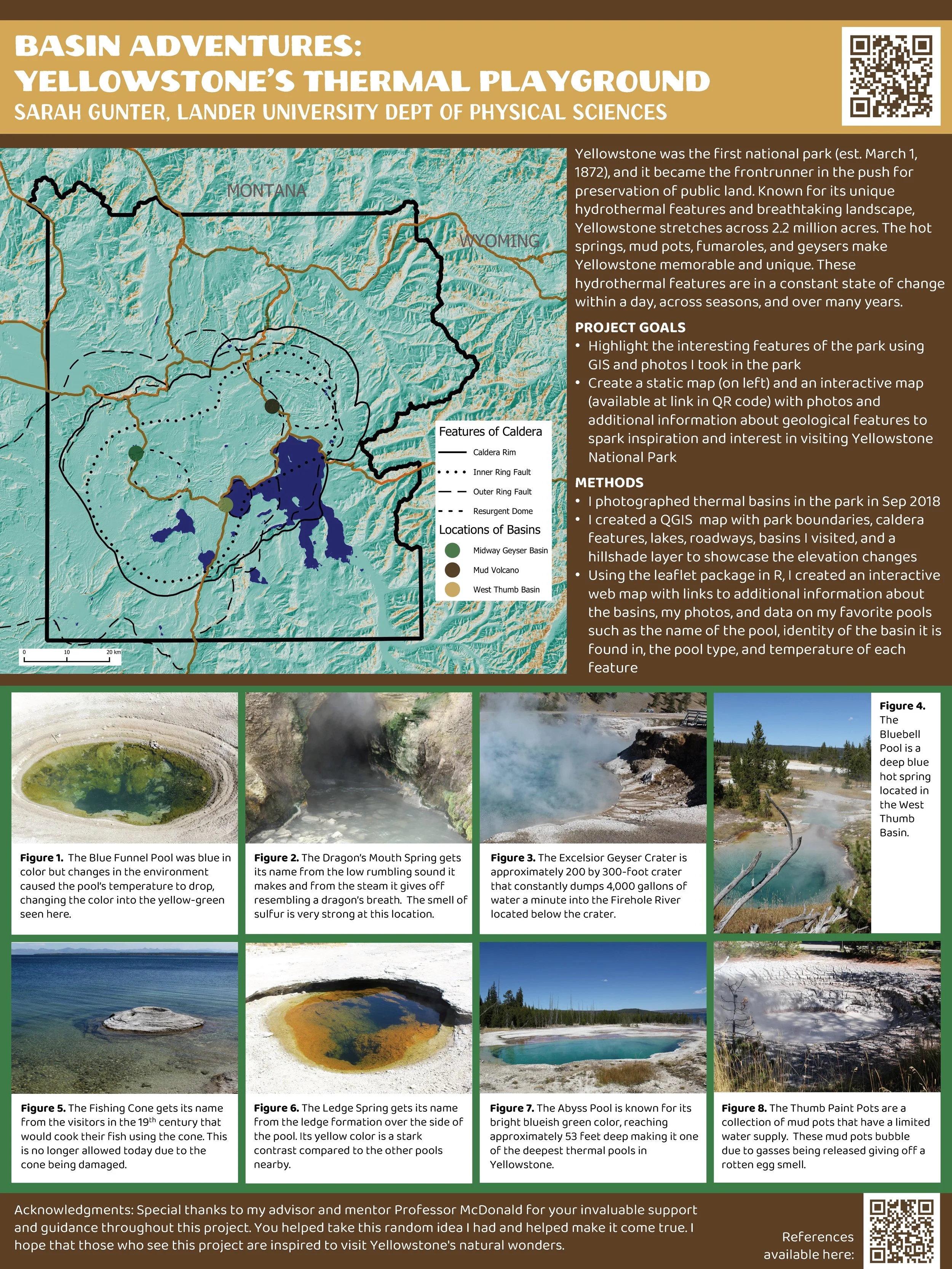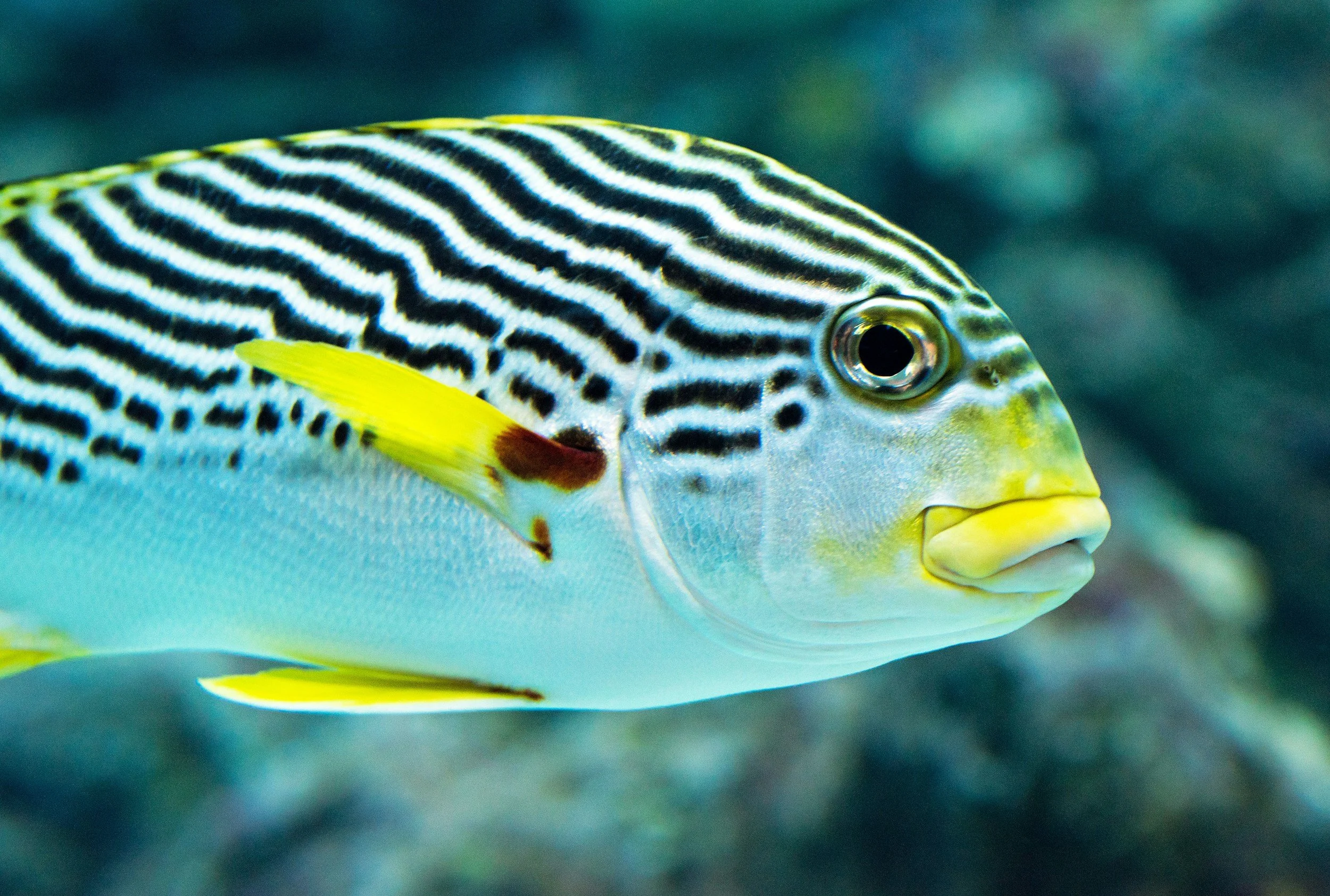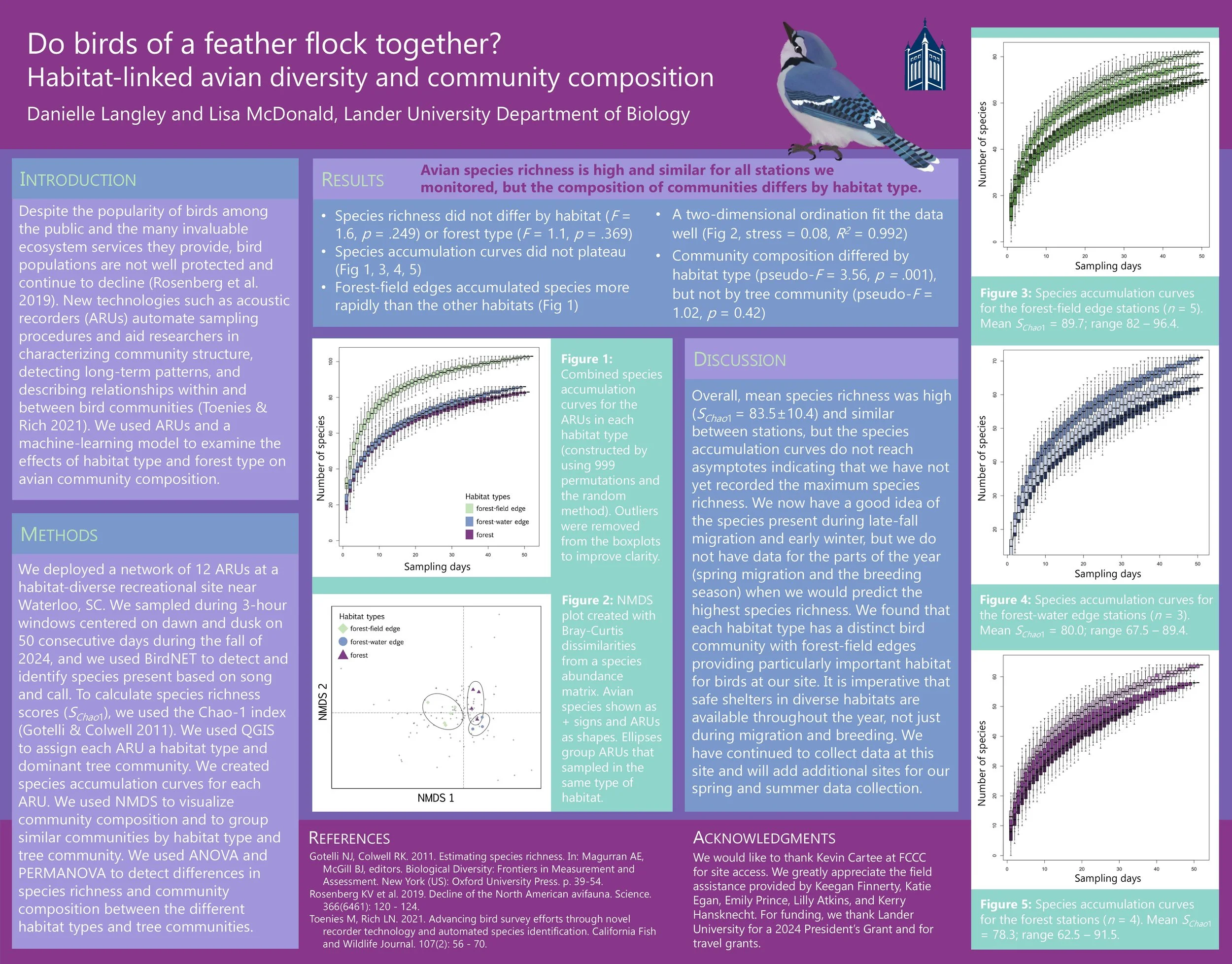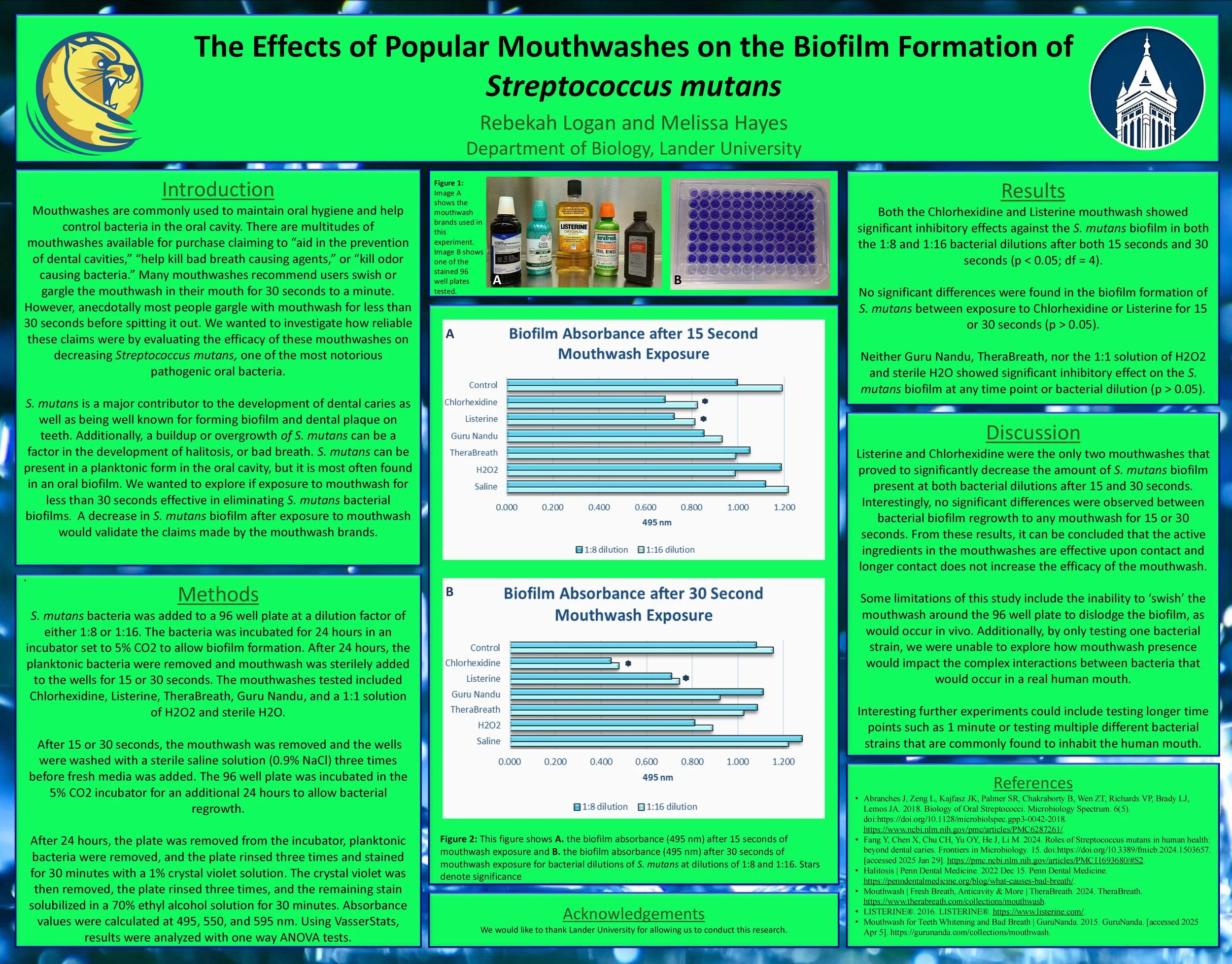Multidisciplinary Poster Session - Biology & Environmental Science
held on April 24, 2025 at the Lander University Academic Symposium
Faculty Sponsors: Elise Donaubauer - Kerry Hansknecht - Melissa Hayes - Lisa McDonald - Emily Prince
Presenters: Keegan Finnerty & Lilliane O'Dell - Sarah Gunter - Ashlyn Kinard & Amaiya McDowell - Danielle Langley - Rebekah Logan
Scroll to view all projects!
-
![]()
Keegan Finnerty & Lilliane O'Dell
Click here to see the poster in more detail.
Living in the shadow of human infrastructure: The effects of artificial lighting on nocturnal mammals
Mammals have varying sensitivities to human disturbances. In Upstate South Carolina, raccoons are frequently found in areas with high human infrastructure while wary animals like rabbits, coyotes, armadillos, and opossums are less common in these areas. Artificial light at night (ALAN) is an aspect of human infrastructure reported to change the migration patterns, foraging behavior, and diel activity of mammals. We sought to determine whether a mammal’s tolerance to human infrastructure was related to its response to artificial lighting. To test this, we altered ALAN levels at 18 camera trap stations around Upstate South Carolina. Each site was illuminated with white light, red light, or no light. We hypothesized that wary nocturnal mammals would be observed less frequently than tolerant mammals at red and white stations. When they were detected at red and white stations, we hypothesized that they would be farther from the camera than at control stations. We identified species captured in images from August 2022 to January 2023 and compared the proportion of observations of tolerant and wary species at each station. For each species, we calculated the proportion of observations in which the animal was close to the camera at each station type. For some species the proportion of observations close to the camera was higher at certain station types, however, no clear association between proximity to the camera and wariness was found. As hypothesized, we found that observations of tolerant species were more common at white than red or control stations, but fewer wary species were observed at white than red or control stations. Overall, this suggests that mammals more tolerant of human infrastructure are less impacted by ALAN and red lighting is less disruptive to wary mammals than white lighting.
Keegan Finnerty is a junior environmental science major from Rock Hill, SC. He is a member of the Honor’s College, treasurer of Lander’s Environmental Science Student Organization, and has presented his research at the annual meeting of the Association of Southeastern Biologists. After graduating in Spring 2026 he plans to attend graduate school with the intention of pursuing a career in ecology.
-
![]()
Sarah Gunter
Click here to see the poster in more detail.
Basin Adventures: Yellowstone's Thermal Playground
Yellowstone was the first national park established March 1, 1872, and it became the frontrunner in the push for preservation of land for future generations to enjoy. Known for its unique hydrothermal features and breathtaking landscape, Yellowstone stretches across 2.2 million acres. In this project, I created a map using satellite imagery, GPS data, and resources from the National Park Service. While on a trip to Wyoming to visit Yellowstone National Park, I took photos of the many hydrothermal pools and geysers located within the park and these are linked to key features of the map. Trailheads, geysers, thermal pools, and walking trails are highlighted in order to assist visitors as they navigate through the park. The primary goal of this project is to provide insight and information about some interesting aspects of the park for visitors and to spark interest in those who have not yet visited.
Sarah Gunter is a senior Environmental Science major from Saluda, SC and the secretary for the Environmental Science Student Organization. She enjoys hiking in our National Parks, fishing, and photography with an emphasis on landscape and macro photography. After graduation she hopes to enter the GIS field of work.
-
![]()
Ashlyn Kinard & Amaiya McDowell
Investigating the role of FRK in Danio rerio development
Fyn Related Kinase (FRK), a non-receptor tyrosine-protein kinase, is heavily involved in many functions inside the cell such as cell differentiation, cell signaling, apoptosis, and proliferation. Previous research has shown that while similar to Src Family Kinases (SFK), it is part of a distinct group of Src related tyrosine kinases including SRM and PTK6. Similar to SFKs, FRK has been studied in different cancer cell lines, such as human breast cancer, melanoma, and human hepatoma. FRK has been identified to be a tumor suppressor kinase that can regulate PI3K/AKT signaling activity, through regulation of PTEN. Activity of FRK occurs through phosphorylation of Tyr497 in the C-Term domain. FRK gene expression in adult Danio rerio tissues was determined following RNA isolation. It was found that high expression exists in the liver, testis, and gallbladder. This project will investigate the role of FRK in developing Danio rerio embryos. FRK Morpholino (FRK MO) was injected into zebrafish embryos, silencing the gene and generating loss of the protein. Preliminary experiments show a decrease in hatching rate and late onset pigmentation following loss of FRK. Future experiments will verify these results and look for any malformations during development. These experiments will provide insight into a potential role for FRK in development under normal conditions.
Ashlyn Kinard is from Prosperity, SC and is a junior medical biology student with minors in chemistry and forensic science. Her achievements include being a member of the Honors College, an independent research student, and a member of the Beta Beta Beta National Honors Society.
Amaiya McDowell is from Iva, SC and is a junior medical biology student with minors in chemistry and sociology. Her achievements include being a member of Delta Sigma Theta Sorority, Incorporated, an independent research student, and a member of the Tri-Beta National Honors Society.
-
![]()
Danielle Langley
Click here to see the poster in more detail.
Do birds of a feather flock together? Habitat-linked avian diversity and community composition
With more than a century of active citizen science and the constant emergence of new technologies, we understand trends in bird population dynamics particularly well. Despite the popularity of birds among the general public and the many invaluable ecosystem services they provide, bird populations are not well protected and continue to drastically decline. In a previous study using camera trap data, we found that bird diversity was highest in areas with increased habitat heterogeneity, but our estimates of species richness were extremely low. In our current study, we chose a site with high habitat heterogeneity and used acoustic recording units (ARU) to identify environmental factors important to avian community composition. We collected data using 12 ARU stations deployed at a 90-acre camping and recreational area near Waterloo, SC. Using GIS, we assigned each ARU a habitat type (surrounded by forest, on the edge of forest and field, or on the edge of forest and water) and predominant tree community (deciduous, conifer, or mixed forest). We used BirdNET to identify the birds present by song and call and calculated species diversity for each station using the Chao-1 index. We visualized our community-level data using NMDS. To detect differences in diversity and to differentiate between the bird communities found within different habitats and tree community types, we used ANOVA and PERMANOVA. Species diversity did not differ between habitat types or tree community types. However, we did find a difference in the community composition of different habitat types with distinct sets of bird species utilizing each habitat type and its resources. Our results emphasize the importance of protecting a wide range of habitats to maximize the number of bird taxa that are protected and to protect as many unique bird communities as possible.
Danielle Langley is a junior biology major from Lexington, SC and is a member of the Honors College. She enjoys birdwatching, reading, and painting in her free time and has given two presentations at the conference of the Association of Southeastern Biologists. Danielle hopes to attend graduate school and obtain a career in ornithology.
-
![]()
Rebekah Logan
Click here to see the poster in more detail.
The effects of popular mouthwashes on the biofilm formation of Streptococcus mutans at different exposure time points
Mouthwashes are commonly used to maintain oral hygiene by controlling bacteria in the oral cavity. Many mouthwashes recommend users gargle the mouthwash for 30 seconds to a minute. Anecdotally, most people gargle with mouthwash for less than 30 seconds before spitting it out. This study was designed to see if exposure to different types of mouthwash for less than 30 seconds was still effective in eliminating Streptococcus mutans biofilms. S. mutans is a common pathogenic oral bacterium that is notorious for being a major contributor to biofilm and dental plaque formation as well as caries development.
In this experiment, we exposed S. mutans biofilms to Chlorohexidine, Listerine, Guru Nandu, TheraBreath, 1:1 H2O2 and water, or a saline solution for 15 seconds or 30 seconds and then allowed biofilm regrowth for 24 hours. We then stained the regrown biofilm with crystal violet and measured the absorbance value to determine cell density. Results indicated that Chlorhexidine and Listerine mouthwash both showed significant inhibitory effects against the S. mutans biofilm. The other commonly used mouthwashes we tried did not show significant inhibitory effect on the S. mutans biofilm. Further research should include testing the bacterial presence immediately after exposure to mouthwash, testing mouthwash efficacy at longer time points, or using combination biofilms to more closely mimic the oral environment.Rebekah Logan is a double major in Biology and Music Performance at Lander University. She enjoys participating in microbiology research and performing viola for community events in Greenwood. After graduation, she will study dentistry at the Dental College of Georgia at Augusta University.
